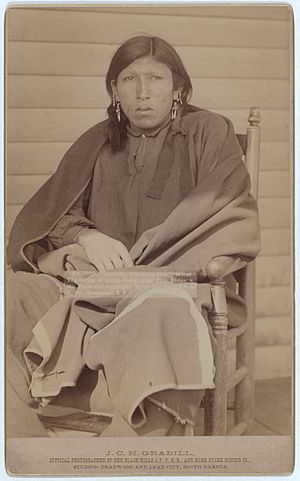Plenty Horses facts for kids
Plenty Horses (born 1869, died 1933) was a Lakota man from the Sicangu (Brulé) group. He lived on the Rosebud Indian Reservation. He is known for an important event that happened on January 7, 1891. This was just nine days after the sad Wounded Knee Massacre. Plenty Horses shot and killed Army Lieutenant Edward W. Casey. Lieutenant Casey was in charge of the Cheyenne Scouts. This event happened near the Stronghold Table in the Badlands of the Pine Ridge Indian Reservation in South Dakota.
Plenty Horses was present at the Drexel Mission Fight, which happened the day after the Wounded Knee Massacre. He was later taken into custody for the killing of Lieutenant Casey. His case went to trial. Plenty Horses said he killed Casey to regain respect from his people. He had spent five years at the Carlisle Indian School. There, he learned about the ways of white society. He returned to his reservation just before the Wounded Knee Massacre.
Five years I attended Carlisle and was educated in the ways of the white man. When I returned to my people, I was an outcast among them. I was no longer an Indian. I was not a white man. I was lonely. I shot the lieutenant so I might make a place for myself among my people. I am now one of them. I shall be hung, and the Indians will bury me as a warrior.
Contents
The Trial of Plenty Horses
The trial of Plenty Horses took place at Fort Meade. This fort was near Sturgis. His trial was very important for understanding the events around the Wounded Knee Massacre. One key question was whether the Lakota people were considered prisoners of war.
Lawyers and Their Argument
Plenty Horses had two lawyers, George Nock and David Powers. They worked for free, which is called pro bono. Their main argument was that a state of war existed between the United States and the Lakota Nation. If there was a war, then soldiers from both sides could kill each other without being charged with a crime. This meant Plenty Horses should not be tried for murder.
They also argued that if there was no war, then the U.S. soldiers who killed Lakota people at Wounded Knee should also face charges.
Judge's Decision
The government wanted the Lakota killed at Wounded Knee to be seen as fighters. They wanted them to be considered prisoners of war who had fought back. On May 28, 1891, Judge Oliver Perry Shiras was in charge of the case. He stopped the trial and told the jury to decide that a state of war did exist. He said the fights between Lakota warriors and the U.S. Army were actual battles.
Judge Shiras explained his decision. He said, "If they were not [battles], it would be hard to justify the killings of the Indians at Wounded Knee and other places."
Witness Testimony
General Nelson A. Miles publicly stated that a state of war did exist at that time. Captain Frank D. Baldwin was a member of General Miles's team. He became an unexpected witness for Plenty Horses. Captain Baldwin was already in the state. He had gone to Pierre to ask the governor to stop selling weapons to Native Americans.
Captain Baldwin's testimony supported Plenty Horses' defense. He said that Plenty Horses had killed Lieutenant Casey because the officer was secretly watching the Native American camp.
Outcome and Later Life
Because the judge decided that a state of war existed, Plenty Horses was not found guilty of murder. He was set free. This decision also helped the soldiers involved in the Wounded Knee Massacre. None of them were ever charged for their actions.
After his trial, Plenty Horses was seen in public only one more time. He appeared at the South Dakota exhibit at the World's Columbian Exposition in Chicago in 1893. After that, he lived a quiet life. He lived until 1933 on the Rosebud Reservation. He married and had children there.


